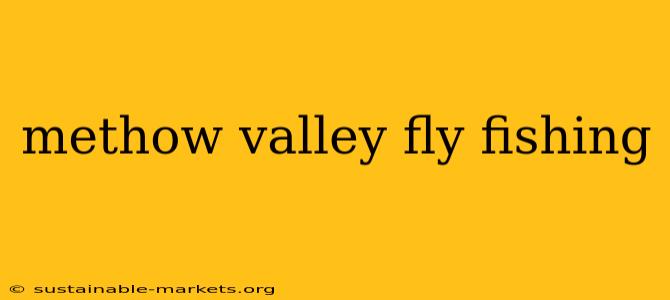The Methow Valley, nestled in the heart of Washington State, is a fly fishing destination of unparalleled beauty and abundance. Known for its pristine rivers, abundant trout populations, and stunning natural scenery, the Methow offers an unforgettable experience for anglers of all skill levels. This guide delves into what makes Methow Valley fly fishing so special, exploring the best rivers, ideal times to visit, and essential tips for a successful trip.
Unparalleled Fishing Opportunities
The Methow Valley boasts a diverse array of waterways, each offering unique fishing challenges and rewards. From the freestone rivers teeming with wild trout to the smaller, secluded streams perfect for intimate encounters with nature, there's a perfect fishing spot for every angler.
The Methow River: A Classic
The Methow River itself is the star of the show, a classic Western river known for its wild rainbow and brown trout. Its varied terrain—from swift riffles to deep pools—provides ample opportunity to test your skills. Dry fly fishing during the summer months is particularly rewarding, with rising trout readily taking terrestrial patterns. However, nymphing and streamer fishing are also effective techniques throughout the year.
The Twisp River: A Hidden Gem
While the Methow River attracts significant attention, the Twisp River remains a less-crowded, equally rewarding option. This smaller river offers a more intimate fishing experience, with plenty of secluded pools and runs. The Twisp is home to a healthy population of rainbow trout and resident fish, offering exciting opportunities for both dry fly and nymph fishing.
Numerous Smaller Streams: Explore and Discover
Beyond the larger rivers, the Methow Valley is crisscrossed with numerous smaller streams and creeks. These hidden gems often provide excellent fishing opportunities, particularly for those seeking a more solitary experience. These waterways are home to wild trout populations and offer a chance to explore the valley's diverse ecosystem. Remember to check regulations before fishing any smaller streams as access and regulations may vary.
Best Time to Visit for Methow Valley Fly Fishing
The best time to visit the Methow Valley for fly fishing depends on your preferred fishing techniques and target species. However, generally, the following periods offer exceptional fishing:
- Spring (April-May): Spring runoff can make some sections of the river unfishable, but the lower sections provide excellent opportunities for fishing emerging insects and actively feeding trout.
- Summer (June-August): Summer offers fantastic dry fly fishing opportunities as terrestrial insects become abundant. This is also a popular time for visitors, so expect higher crowds on the more accessible stretches of river.
- Fall (September-October): Fall brings cooler temperatures and vibrant colors. Trout are actively feeding in preparation for winter, offering excellent fishing opportunities with nymphs and streamers.
Essential Tips for a Successful Trip
- Obtain a Washington State Fishing License: This is essential before heading out to any fishing spot in the Methow Valley.
- Check Regulations: Regulations can vary between rivers and streams, so always check the current rules and regulations before fishing.
- Respect the Environment: Practice Leave No Trace principles and respect the delicate ecosystem of the Methow Valley.
- Hire a Guide: Consider hiring a local guide, particularly if you're new to the area or looking to target specific species. A guide can provide invaluable insights into local conditions and techniques.
- Pack Appropriately: The weather in the Methow Valley can change quickly, so pack layers, rain gear, and appropriate footwear.
Conclusion: An Unforgettable Fly Fishing Experience
Methow Valley fly fishing is a truly unforgettable experience, blending stunning natural beauty with exceptional fishing opportunities. Whether you're an experienced angler or just starting your fly fishing journey, the Methow Valley offers something for everyone. Plan your trip today and discover the magic of this incredible destination. Remember to always respect the environment and follow all regulations to ensure the preservation of this natural treasure for generations to come.

